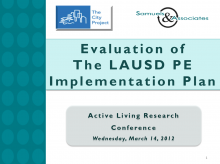We are pleased to announce an exciting new alliance between Active Living Research and GP RED to co-host and coordinate...
Evaluation of the Los Angeles Unified School District Physical Education Policy Implementation Plan

Presentation at the 2012 Active Living Research Annual Conference.
View the associated research paper.
Background
Obesity rates in Los Angeles Unified School District (LAUSD) students are above the national average and continue to increase. The district serves more than 675,000 students, 90% of whom are students of color and three-quarters of whom qualify for free-/reduced price meals. Evidence suggests that physical education (PE) of sufficient quantity and quality is an important strategy to prevent childhood obesity. This study assessed the passage and implementation of a district policy to improve PE in LAUSD. Formally adopted in Fall 2009 as a result of a community campaign to address inequities across the district, the policy aims to enforce existing requirements for minimum minutes of PE, PE content, class size, and teacher credentialing.
Objective
- Describe the community campaign and process that resulted in the successful passing of the LAUSD PE policy.
- Demonstrate how social science research can be applied to drive policy change.
- Share evaluation results of PE class observations and discuss the impact of the PE policy one year after implementation.
- Explain and discuss the benefits and challenges of using the method of a district-wide policy to improve physical education and ultimately students’ health and fitness.
Methods
To examine the strategies, successes and challenges in adopting the PE policy, semi-structured stakeholder interviews were conducted in the spring of 2011 with 18 individuals including principals, teachers, parents, board members, the former superintendent, and representatives from community organizations that were involved in the advocacy campaign.
In fall and winter of 2010, primary data were collected in a random sample of 34 LAUSD schools and 13 schools in nearby comparison districts with 5th 7th or 9th grade students through observation of PE classes and interviews with school personnel while visiting school campuses. The observations used a modified SOFIT to assess quality and observed PE class length, content and size, and interviewed school personnel to document PE curriculum used, frequency of classes, teacher credentials and awareness of the PE policy.
Results
Stakeholders agreed the PE policy was the most effective method to improve PE district-wide. The most important outcome of the campaign was the increase in awareness of the benefits students gain from PE and a greater understanding of the requirements in California’s PE laws. There were some challenges during the passage of the policy, but the largest challenge has been actual implementation of the PE policy due to the budget cuts in the current economic climate.
The observations found LAUSD schools are implementing PE requirements to varying degrees and their class quantity and quality is similar to classes in nearby comparison districts. LAUSD secondary school students are generally meeting the number of minutes required in PE, but the amount of physical activity they are engaged in during those minutes varies, and on average students do not spend at least 50% of the class engaged in moderate to vigorous physical activity. The average class size is around 48 students in LAUSD secondary schools and they all have credentialed teachers dedicated to teaching PE. On average, elementary schools are not meeting the required minutes for PE and do not have credentialed teachers dedicated to PE; they are spending an average of 30% of their classtime in moderate to vigorous physical activity. Due to the increased awareness of the importance of PE that resulted from the PE policy, though, some schools have been working to improve the quantity and quality of PE they provide. Preliminary analyses have been conducted comparing schools in LAUSD to nearby districts and significant differences were not found, more in-depth findings will be presented at the conference.
Conclusions
This study provides much-needed evidence as to whether school districts can successfully implement a policy that positively impacts the provision of PE and improve the health and physical fitness of students. Middle and high schools are generally meeting the California state standards for PE, but the quality needs to be improved to encourage more physical activity during PE class. Elementary schools need support through teacher trainings or additional resources to begin meeting the state standards for PE minutes and content. This on-going study will continue to assess the implementation of the PE policy through the 2011/2012 school year and will also analyze observed physical activity levels during PE classes in LAUSD and control school districts. These additional findings will provide more insight on how to encourage more frequent PE that encourages students to be physically active.
Support/Funding
This study was supported through a Rapid Response grant from Active Living Research, a program of the Robert Wood Johnson Foundation. The study team has received a second grant from Active Living Research, which is allowing a second round of full data collection and analysis of physical activity levels during PE classes.
- DOWNLOAD "2012_SchoolPolicyEval_Lafleur.pdf" PDF (1.02 MB) Presentations
Related Tools & Resources
STAY UP TO DATE
RECENTLY ADDED TOOLS & RESOURCES
MOVE! A BLOG ABOUT ACTIVE LIVING
The "Active Living Conference" aims to break down research and practice silos and...







